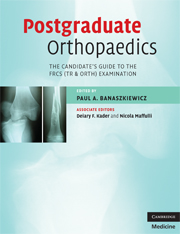Book contents
- Frontmatter
- Contents
- List of contributors
- Foreword by Mr Peter Gibson
- Preface
- Glossary
- Section 1 The FRCS (Tr & Orth) examination
- Section 2 The written paper
- Section 3 The clininicals
- 3 The short cases
- 4 Short case list
- 5 The long cases
- 6 Long case list
- 7 Hand and wrist clinical cases
- 8 Shoulder and elbow clinical cases
- 9 Spine clinical cases
- 10 Hip clinical cases
- 11 Knee clinical cases
- 12 Foot and ankle clinical cases
- 13 Paediatric clinical cases
- Section 4 Adult elective orthopaedics oral
- Section 5 The hand oral
- Section 6 The paediatric oral
- Section 7 The trauma oral
- Section 8 The basic science oral
- Section 9 Miscellaneous topics
- Index
3 - The short cases
from Section 3 - The clininicals
Published online by Cambridge University Press: 22 August 2009
- Frontmatter
- Contents
- List of contributors
- Foreword by Mr Peter Gibson
- Preface
- Glossary
- Section 1 The FRCS (Tr & Orth) examination
- Section 2 The written paper
- Section 3 The clininicals
- 3 The short cases
- 4 Short case list
- 5 The long cases
- 6 Long case list
- 7 Hand and wrist clinical cases
- 8 Shoulder and elbow clinical cases
- 9 Spine clinical cases
- 10 Hip clinical cases
- 11 Knee clinical cases
- 12 Foot and ankle clinical cases
- 13 Paediatric clinical cases
- Section 4 Adult elective orthopaedics oral
- Section 5 The hand oral
- Section 6 The paediatric oral
- Section 7 The trauma oral
- Section 8 The basic science oral
- Section 9 Miscellaneous topics
- Index
Summary
Many candidates regard the short cases as the most difficult part of the FRCS Orth examination. The aim is for a safe comfortable pass. Often examiners say that there are very few surprises in the short cases as for sure a “Rheumatoid” or “Dupuytren's” hand is certain to be present in the examination hall. However, there are also rare or more complex cases and these can catch you out if you are not familiar with them.
A recent major change in the format of the short cases exam was to divide it into upper and lower limb sections. These last 15 minutes each but with the same pair of examiners. Previously there was a more random allocation of short cases although in fairness there was usually a balanced mix of both upper and lower limb cases.
When unsure of something we can all say stupid things to the examiners in the heat of the moment. Easy cases can be ruined and failed if things are going badly. Some candidates would claim that the key to the short cases is a good start with the opening first two cases. A poor start can easily deteriorate into a fail if you are unable to turn it around. Avoid the downward spiral. Try not to become demoralized, take a deep breath and attack the next case anew. Allowances are usually made for first-case nervousness but if this continues into the second or third case examiners will quickly lose patience and fail you.
- Type
- Chapter
- Information
- Postgraduate OrthopaedicsThe Candidate's Guide to the FRCS (TR & Orth) Examination, pp. 13 - 14Publisher: Cambridge University PressPrint publication year: 2008



